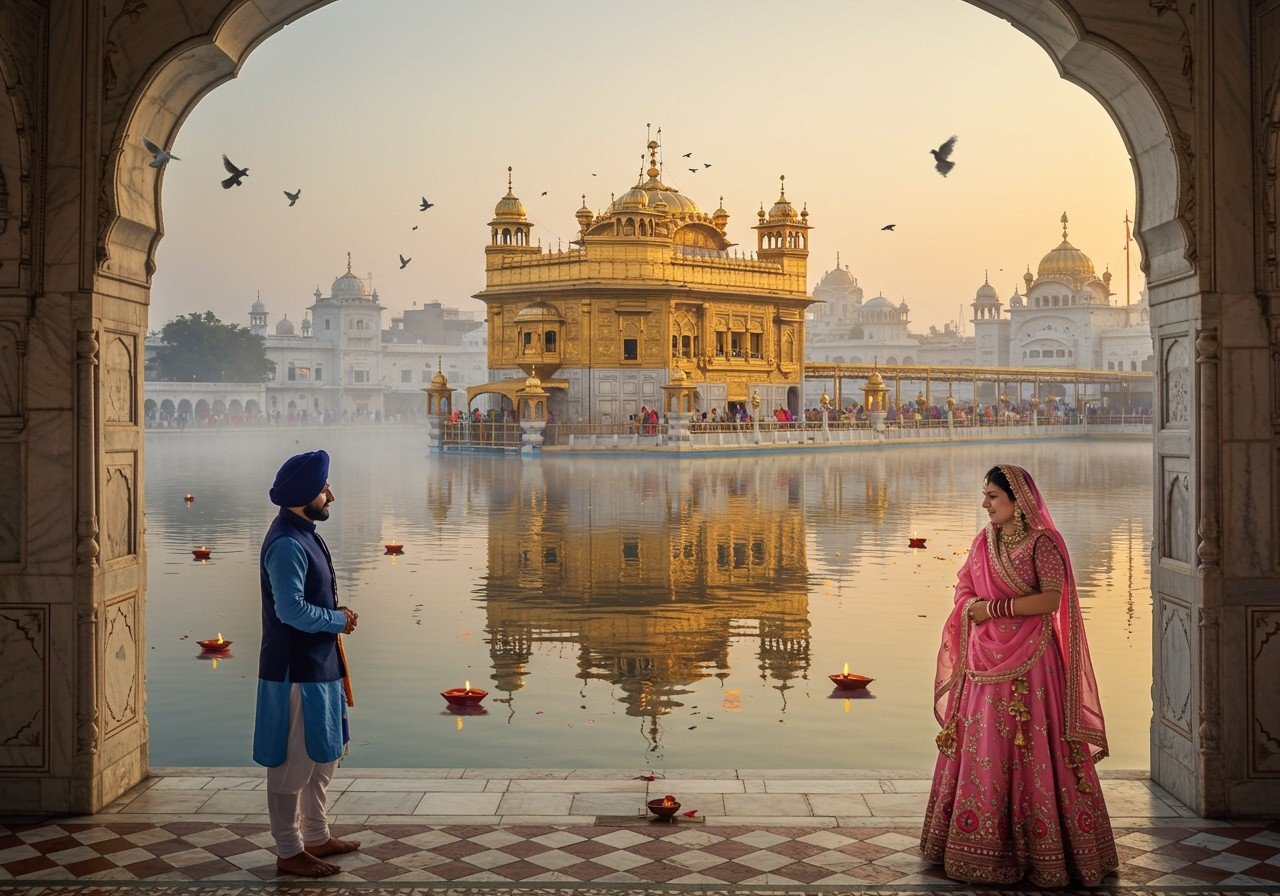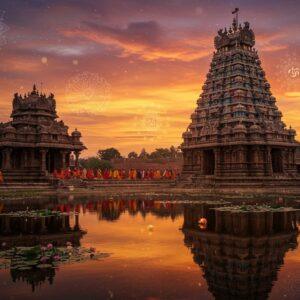
Journey through Punjab, the land of five rivers, where spirituality and culture intertwine. Discover the rich heritage of Sikhism and Punjabi culture through magnificent temples and deeply rooted traditions. This guide explores the sacred sites of the Golden Temple, Anandpur Sahib, and Fatehgarh Sahib, unraveling their historical and cultural significance.
Golden Temple – The Heart of Sikh Devotion
Explore the Golden Temple (Harmandir Sahib), Sikhism’s holiest shrine. Witness its architectural grandeur, with gold-plated walls and an exquisite marble base. Discover the Amrit Sarovar, the holy tank, where pilgrims seek spiritual purification.
Key Highlights:
- Langar: The community kitchen serves free meals to thousands daily, symbolizing equality and communal harmony. This tradition embodies the Sikh principle of selfless service (seva) and ensures that no one goes hungry, regardless of their background.
- Akal Takht: The highest seat of Sikh temporal authority, guiding the Sikh community. It represents the spiritual and political sovereignty of the Sikhs and plays a crucial role in religious matters.
- Palki Sahib Ceremony: Experience the serene evening ambiance as the Guru Granth Sahib is carried to its resting place. This ritual is a beautiful display of reverence for the Sikh holy scriptures.
- Operation Blue Star: Gain insights into the historical events of 1984. This event holds significant historical and political implications for the Sikh community.
- Artwork and Inscriptions: Explore intricate artwork depicting stories from Sikh history and teachings. These artistic expressions showcase the rich heritage and traditions of Sikhism.
Anandpur Sahib – The Birthplace of Khalsa
Visit Anandpur Sahib, where Guru Gobind Singh founded the Khalsa in 1699. Understand the significance of Takht Sri Keshgarh Sahib, one of Sikhism’s five Takhts, where the Khalsa was initiated.
Discoveries:
- Hola Mohalla Festival: Witness this grand celebration of Sikh martial arts, bravery, and brotherhood. This vibrant festival showcases the physical and spiritual strength of the Sikh community.
- Historical Gurdwaras: Explore numerous gurdwaras, each with unique stories and significance. These sites offer insights into the rich history and diverse aspects of Sikhism.
- Virasat-e-Khalsa Museum: This museum showcases the rich history and heritage of Sikhism through interactive exhibits and displays. Learn about the evolution of the Sikh faith and its impact on the region.
- Principles of Sikhism: Understand the core values of valor, sacrifice, and equality, deeply connected with Anandpur Sahib. This city embodies the spirit of Sikhism and its commitment to social justice.
- Peaceful Atmosphere: Experience tranquility in the foothills of the Shivalik range. The serene environment offers a peaceful escape for reflection and spiritual contemplation.
Fatehgarh Sahib – A Symbol of Sacrifice
Discover Fatehgarh Sahib, a site of immense historical and emotional significance. Learn about the martyrdom of Guru Gobind Singh’s younger sons, Baba Zorawar Singh and Baba Fateh Singh.
Important Aspects:
- Gurdwara Fatehgarh Sahib: This gurdwara stands at the site of their martyrdom, serving as a poignant reminder of their sacrifice. It is a place of pilgrimage and remembrance for Sikhs worldwide.
- Gurdwara Jyoti Swarup: This is where the cremation of the martyrs took place, marking a somber moment in Sikh history. The gurdwara commemorates their sacrifice and the resilience of the Sikh faith.
- Shaheedi Jor Mela: This annual December event commemorates the martyrdom of the Sahibzadas. It is a time for reflection, remembrance, and reaffirming the Sikh values of courage and faith.
- Themes of Sacrifice and Resilience: Reflect on these themes as embodied by the events at Fatehgarh Sahib. The story of the Sahibzadas serves as an inspiration to Sikhs around the world.
- Historical Context: Learn about the historical context, including the siege of Anandpur Sahib. This period of Sikh history marked by significant challenges and struggles, highlights the community’s unwavering faith.
Cultural Traditions and Practices
Dive into Punjab’s vibrant cultural traditions intertwined with Sikhism. Explore Baisakhi’s significance, the harvest festival marking the Khalsa’s establishment. Understand the importance of traditional attire like the turban (Dastar) and Phulkari embroidery.
Discover traditional Punjabi folk music and dance (Bhangra and Giddha). Learn about Punjabi cuisine and its rich flavors, often enjoyed in Langars. Understand Sikh wedding customs, including the Anand Karaj ceremony.
Explore Sikh martial traditions like Gatka, promoting physical fitness and cultural preservation. Discover the values of Seva (selfless service) and Simran (meditation), central to Sikhism and Punjabi culture. For those seeking to deepen their spiritual practice, poojn.in offers a wide selection of meditation accessories.
Embrace the Journey
Embrace this journey through Punjab’s temples and traditions. Immerse yourself in spiritual enlightenment and cultural richness. Enhance your spiritual experience with authentic puja items and religious artifacts available at poojn.in, India’s largest cultural goods and services store. We offer a wide range of products, from deities to incense holders, to enhance your spiritual practice.
FAQs
What is the significance of the Golden Temple? The Golden Temple is the holiest shrine in Sikhism, symbolizing God’s eternal throne.
How can I visit the Golden Temple? Travel to Amritsar, Punjab. Remember to cover your head and remove your shoes before entering.
What is Anandpur Sahib known for? Anandpur Sahib is the birthplace of the Khalsa, founded by Guru Gobind Singh in 1699.
Can I stay at Anandpur Sahib? Yes, accommodations include gurdwara lodgings and hotels.
Why is Fatehgarh Sahib important? It marks the martyrdom of Guru Gobind Singh’s younger sons.
What are some key Sikh traditions? Langar, daily prayers, wearing the Five Ks, and celebrating festivals like Vaisakhi.
Is there a dress code for Sikh temples? Yes, cover your head and remove your shoes. Modest clothing is encouraged.
How can I learn more about Punjabi culture? Participate in festivals, visit historical sites, engage with locals, and try traditional cuisine.


